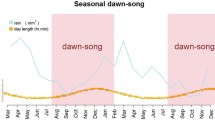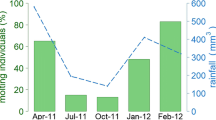ABSTRACT
The duration of life history state (LHS) reflects the adaptive strategy a species has evolved to cope with a changing environment. Inhabitants at different latitudes may thus have significant differences in the rates of metabolic and physiological processes underlying LHSs. Birds, in order to maximize their fitness in the environment in which they live, seasonally switch from one LHS to another during the year. The present study investigated whether an annual itinerary of a species would determine its rate of reaction to inductive long days. We compared the photoinduced cycles of changes in body mass and testes, as indices of migratory and reproductive LHSs, between two long day breeding species, the migratory redheaded bunting and non-migratory Indian weaverbird. Changes in body mass and testis size were measured in photosensitive buntings and weaverbirds (n = 7 each) on short days (LD 8:16) subjected first to 0.5 h weekly light increments until the light period was 13 h per day, and then maintained on LD 13:11 for another 32 weeks. A similar observation was recorded on a group of buntings (n = 14) and weaverbirds (n = 9) maintained on increasing natural day lengths (NDL; Lucknow, 26°55' N, 80°59' E) for 47 weeks. As predicted, the rates of induction of seasonal cycles under an identical inductive photoperiod were significantly faster in temperate buntings with five annual LHSs than in the subtropical weaverbirds with three annual LHSs. This suggests that annual itineraries of songbirds with which they may have evolved with at their breeding latitudes, determine their response to the external photoperiodic environment.


Similar content being viewed by others

References
Ali S and Ripley SD 1974 Handbook of the birds of India and Pakistan, vol. 10 (New York: Oxford University Press)
Bradshaw WE and Holzapfel C 2007 Evolution of animal photoperiodism. Annu. Rev. Ecol. Evol. Syst. 38 1–25
Budki P, Rani S and Kumar V 2012 Persistence of circannual rhythms under constant periodic and aperiodic light conditions: sex differences and relationship with the external environment. J. Exp. Biol. 215 3774–3785
Cardillo M 2002 The life-history basis of latitudinal diversity gradients: how do species traits vary from the poles to the equator? J. Anim. Ecol. 71 79–87
Caro SP, Balthazart J, Thomas DW, Lacroix A, Chastel O and Lambrechts MM 2005 Endocrine correlates of the breeding asynchrony between two Corsican populations of blue tits (Parus caeruleus). Gen. Comp. Endocrinol. 140 52–60
Cooper CB, Margaret A, Voss MA, Ardia DR, Austin SH and Robinson WD 2011 Light increases the rate of embryonic development: implications for latitudinal trends in incubation period. Funct. Ecol. 25 769–776
Dawson A 2007 Seasonality in a temperate zone bird can be entrained by near equatorial photoperiods. Proc. Royal Soc. Biol. Sci. 274 721–725
Gwinner E 1996 Circadian and circannual programmes in avian migration. J. Exp. Biol. 199 39–48
Hau M 2001 Timing of breeding in variable environments: tropical birds as model systems. Horm. Behav. 40 281–290
Helm B, Schwabl I and Gwinner E 2009 Circannual basis of geographically distinct bird schedules. J. Exp. Biol. 212 1259–1269
Kumar V, Singh S, Misra M and Malik S 2001 Effects of duration and time of food availability on photoperiodic responses in the migratory male blackheaded bunting (Emberiza melanocephala). J. Exp. Biol. 204 2843–2848
Kumar V, Singh S, Misra M, Malik S and Rani S 2002 Role of melatonin in photoperiodic time measurement in the migratory redheaded bunting (Emberiza bruniceps) and the nonmigratory Indian weaver bird (Ploceus philippinus). J. Exp. Zool. 292 277–286
Martin TE 1996 Life-history evolution in tropical and south temperate birds: what do we really know? J. Avian Biol. 27 1–10
Perfito N, Meddle S, Tramontin AD, Sharp P and Wingfield JC 2005 Seasonal gonadal recrudescence in song sparrows: Response to temperature cues. Gen. Comp. Endocrinol. 143 121–128
Perfito N, Tramontin AD, Meddle S, Sharp P, Afik D, Gee J, Ishii S, Kikuchi M and Wingfield JC 2004 Reproductive development according to elevation in a seasonally breeding male songbird. Oecologia 140 201–210
Rani S, Singh S, Misra M, Malik S, Singh BP and Kumar V 2005 Daily light regulates seasonal responses in the migratory male redheaded bunting (Emberiza bruniceps). J. Exp. Zool. 303A 541–550
Rani S, Singh S and Kumar V 2007 Photoperiodism, pineal clock and seasonal reproduction in the Indian weaver bird (Ploceus philippinus). J. Ornithol. 148 601–610
Ricklefs RE 1976 Growth rates of birds in the humid new world tropics. Ibis 118 179–207
Ricklefs RE 1980 Geographical variation in clutch size among passerine birds: Ashmole’s hypothesis. Auk 97 38–49
Ricklefs RE 2000 Density dependence, evolutionary optimization, and the diversification of avian life histories. Condor 102 9–22
Root T 1988 Energy constraints on avian distributions and abundances. Ecology 69 330–339
Russell EM, Yom-Tov Y and Geffen E 2004 Extended parental care and delayed dispersal: Northern, tropical, and southern passerines compared. Behav. Ecol. 15 831–838
Saether SA 1988 Pattern of covariation between life-history traits of European birds. Nature 331 616–17
Singh J, Budki P, Rani S and Kumar V 2012 Temperature alters the photoperiodically controlled phenologies linked with migration and reproduction in a night-migratory songbird. Proc. Roy. Soc. B. 279 509–515
Snow DW and Lill A 1974 Longevity records for some neotropical land birds. Condor 76 262–267
Wiersma P, Munoz-Garcia A, Walker A and Williams JB 2007 Tropical birds have a slow pace of life. Proc. Natl. Acad. Sci. USA 104 9340–9345
Wikelski M, Spinney L, Schelsky W, Scheuerlein A and Gwinner E 2003 Slow pace of life in tropical sedentary birds: a common-garden experiment on four stonechat populations from different latitudes. Proc. R. Soc. Lond. B. 270 2383–2388
Wingfield JC 2008 Organization of vertebrate annual cycles: implications for control mechanisms. Phil. Trans. R. Soc. B. 363 425–441
Wingfield JC and Kitaysky AS 2002 Endocrine responses to unpredictable environmental events: stress or anti-stress hormones? Integ. Comp. Biol. 42 600–609
Wingfield JC, Breuner C, Jacobs J, Lynn S, Maney D, Ramenofsky M and Richardson R 1998 Ecological bases of hormone-behavior interactions: The ‘emergency life history stage’. Amer. Zool. 38 191–206
Acknowledgements
The Department of Science and Technology (IR/SO/LU-02/2005), New Delhi, India, funded this study.
Author information
Authors and Affiliations
Corresponding author
Additional information
MS received 21 August 2013; accepted 15 April 2014
Corresponding editor: Renee Borges
[Malik S, Singh S, Rani S and Kumar V 2014 Life at a different pace: Annual itineraries are conserved in seasonal songbirds. J. Biosci. 39 1–7] DOI 10.1007/s12038-014-9440-1
Rights and permissions
About this article
Cite this article
Malik, S., Singh, S., Rani, S. et al. Life at a different pace: Annual itineraries are conserved in seasonal songbirds. J Biosci 39, 485–491 (2014). https://doi.org/10.1007/s12038-014-9440-1
Received:
Accepted:
Published:
Issue Date:
DOI: https://doi.org/10.1007/s12038-014-9440-1



